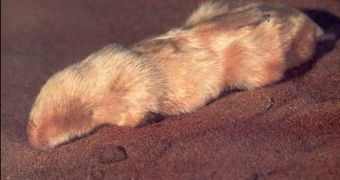Scientists have always thought that the Australia’s weird and mysterious marsupial mole came from an unknown desert, but the discovery of the first fossil record of one of their ancestors, showed everyone that they were far away from the truth.
Living marsupial mole are blind, have no ears and live underground in the deserts of Western Australia, Northern Territory and south Australia, but their ancestors had a very different lifestyle – they spent their lives in the luxurious rainforest far away in north Queensland.
“This fossil discovery came as a real shock,” said Professor Mike Archer, of the University of New South Wales (UNSW), leader of the team.
“Until now, we had always assumed that marsupial moles must have evolved in an unknown ancient Australian desert because, the living marsupial moles survive only in deserts.
“Yet this ancestral Australian mole, which is not as specialized as the living form, has been discovered in ancient rainforest deposits—not deserts.
“The fossils suggest that they became mole-like while burrowing through the mossy floors of those ancient forests.”
This discovery of the 20 million-year-old fossil at the Riversleigh World Heritage fossil site is like the missing link, and it also cleared out another enigma – the evolution of the V-shaped teeth of the living marsupial mole.
Dr Robin Beck of the American Museum of Natural History, says that even if they look like the teeth of the Cape golden mole which lives in Africa, the different evolutionary pathways before getting to a similar result are more clear.
The living marsupial moles are related to kangaroos, koalas and other marsupials, but they do look much like their African siblings – they have the same golden fur and also similar teeth and skeletons.
The only difference (and a big one) is that the Cape golden mole is a placental mammal, like bats, rats, elephants and humans are.
So what Professor Archer says is that some 125 million years ago, these two very different mammal branches evolved from the same ancestor, even if because of their similar lifestyle, they still have many things in common.
“This ancient link makes it clear that marsupials followed a completely different path from placentals but ended up with almost identical-looking teeth.”
"It goes to the heart of global debates about relationship versus convergence - whether animals are similar because they are closely related or similar because they have had to adapt to related challenges,” said co-author UNSW Associate Professor Suzanne Hand.
The findings were published in the journal Proceedings of the Royal Society B.

 14 DAY TRIAL //
14 DAY TRIAL //